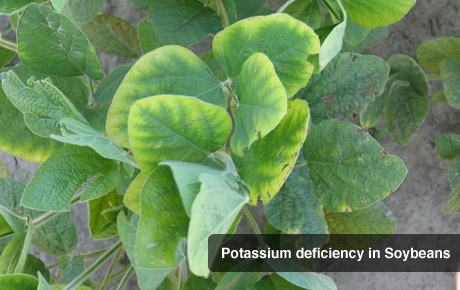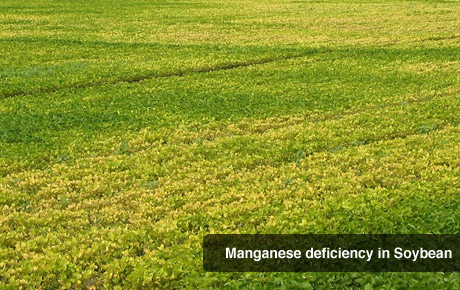With the potential for higher soybean yields with each passing year, the need for a strong, healthy crop continues to rise. It also requires a high level of management that starts with scouting.
Scouting soybeans for nutrient deficiencies should take place throughout the growing season. And, as you scout for these deficiencies, be sure to take the time to also scout for pests and diseases. If problematic, all three can cause a substantial decrease in yield by harvest time.
Most nutrient deficiencies will appear in the early stages of soybean growth — from the first trifoliate through the R1 stage, or when the soybean begins to flower. All nutrient deficiencies in soybeans appear as a change in color, often yellowing of the leaves. However, disease and pests can induce the same color change in soybeans, so it’s important to scout accurately and thoroughly, and use high-quality references available to accurately identify the problem. Crop scouting guides from the University of Illinois, Iowa State and Purdue are all good resources, as is the photo library in the Nutrient Knowledge section of CropNutrition.com.
When scouting, find the high point in a field, and look across the field as a whole, identifying where coloring looks lighter or plants look shorter. Those are the areas to look at first. Be sure to bring a soil probe and a spade with you to collect samples.
As you approach problematic areas in the field, examine the entire plant, starting from the ground up. Keep a close eye out for pests, such as two-spotted spider mites or evidence of cyst nematodes. Both can cause yellowing of a plant, similar to nutrient deficiencies. Pay close attention to which leaves are carrying a lighter-green or yellow color. Color change on lower leaves can signify a different nutrient deficiency than leaves on top of the plant. For example, potassium deficiencies appear on lower, older leaves of the soybean plant, while manganese deficiencies appear on the top, younger leaves.


Aside from nutrient deficiencies, pests or disease, yellowing of soybean plants can also be caused by overapplication of herbicides and soil compaction. So, to accurately diagnose the problem in the field, it is important to look at the entire plant, from root to tip. In fact, consider digging up the root systems of a few plants in lighter-colored areas to look closely for cyst nematodes. Once the pest takes hold in a field, it can be devastating to yields.
For 2014, pay particular attention to wet areas of soybean fields. The wet spring and regional downpours in early summer may lead to sulfur deficiencies due to leaching. They may also cause poor aeration in the soil, which causes the rhizobia bacteria on the roots of the soybean to drown, therefore minimizing its ability to fix nitrogen. If you spot signs of sulfur or nitrogen deficiencies, consider the weather patterns earlier in the season.
As you scout and find questionable areas in your field, take soil samples. Likewise, take soil samples in the areas of your field where the soybeans are deep green, healthy and tall. Comparing the different soil analyses will help determine what nutrients are missing for optimum yields. The same goes for tissue samples. Using all of that data, and comparing it to prior years’ data, makes it easier to develop an effective fertilizer plan for the following year that will minimize nutrient deficiencies and maximize yields.
Ideally, fertilizer applied at the start of the growing season should be applied in concentrations that eliminate the chance for nutrient deficiencies to develop. This proactive approach is the surest way to optimize the yield potential of each plant. After all, once visible signs of deficiencies are found in the field, some yield is already lost. The biggest challenge to scouting fields well is making the time to do it. However, when you take the time to invest in your field and in your knowledge base, you can better plan for higher yields in the coming years.